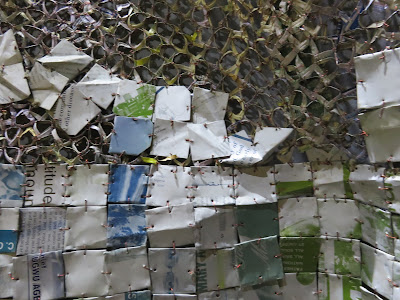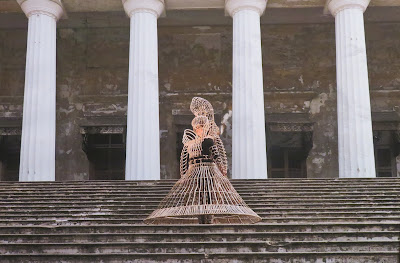The Biennale catalogue lists 26 national pavilions in the Arsenale. Those are in addition to the 29 official ones at the Giardini and the scores of them in apartments, shops, palaces, warehouses, and other venues hidden across the city. I’ve selected only a few that particularly caught my attention.
Because I made a couple of trips Amazon Peru in the ‘90s, starting in Iquitos, I was quite taken by Christian Bendayán’s rather complex installation in the Peruvian pavilion, “Indios Antropofágos”. A Butterfly Garden in the Jungle. Based on “exoticized images of jungle natives,” his Spanish tile compositions depicted transgender and transvestite characters enacting exaggerated versions of early 20th-century postcards of native people of Peru. Versions of the postcards, showing native Peruvians dancing or posing in groups are also included in this richly conceived installation. The backgrounds of the tile compositions copied watercolors of Iquitos – on view in the exhibition - by the lepidopterist Otto Michael, who published books on Amazon butterflies after three multi-year expeditions to Peru between 1885 and 1921. Michael’s books are also on display, titled “Butterfly Hunter of the Amazon,” and Bendayán has included collages of Amazonian women with butterfly wings. This is a rich and dense installation, full of history, anthropology, socology and biology, very rewarding if one takes the time to look carefully. And the tiles, azulejos, are brightly colored and cheerful.

Kosovo’s Family Album is a video installation by Alban Muja that captured my attention for many minutes, as adults describe the meaning and memories they derive from photographs of themselves as children displaced by the Kosovo War of 1998-99. Their straightforward descriptions of the events they survived and their calm demeanor made the stories chilling.
The Ukraine Pavilion was somewhat ephemeral, but engaging, especially to Tom. As their entry to the Biennale, Ukraine sent the worlds largest cargo plane the Antonov AN-225 MRIYA on a flight over Venice on May 9, 2019, casting its shadow over the Giardini del Biennale. In the cargo hold was a digital directory of all living Ukrainian artists.
 |
| brochure cover about the Antonov 224 cargo plane |
Layers of suspended black paper made up the installation by Joël Andrianomearisoa for the Madagascar Pavilion, that country’s first representation at Venice. It is beautifully simple, dark but not completely negative in feeling.
Latvian artist Daiga Grantina presented an installation of brightly colored forms suspended from the ceiling, leaning on the walls and resting on the floor, titled Saules Suns. They seemed playful, organic, cheerful, and a little menacing.
Ghana also had its first representation at Venice and chose to make a substantial pavilion, designed by Sir David Adjaye, the Ghanian-British architect. Among several artists included there were Lynette Yiadom-Bonkye, a very good painter, Felicia Abban, a photographer, and the famous ubiquitour El Anatsui, with several enormous wall pieces made as usual, from bottle caps and the like. They were so big I couldn't capture them in photographs.
 |
| Felicia Abban, Untitled Self-Portraits, ca. 1060s-70s |
 |
Lynette Yiadom-Boakye, The Mighty, Mighty Lines, 2019, oil on linen
El Anazui, Yaw Berko, 2019, aluminum printing plates, bottle tops, and copper wires. |
Among the several large pavilions at the end of the Arsenale building, we were most interested in India. The installation, Our Time for aFuture Caring, is based on the memory of Mahatma Gandhi. It opens with images of Gandhi and a quotation from him, “I am not a seer, rishi or philosopher of non-violence; I am only an artist on non-violence and desire to develop the art of non-violence in the realm of resistance,” Mohandas Karamchand Gandhi. The works of several younger artists and senior artists like Nandalal Bose, all refer to Gandhi’ s teachings and impact on India. I’ve chosen to focus on just two. The first installation, by GR Iranna, We Together, 2012, two walls full of single Indian sandals of the type worn by Gandhi, is another example of repeating the same element, in this instance peasant sandals, to larger effect than just a few sandals, a photograph or a painting would have. To me it spoke of all the kinds of people who wear this footwear, and all the walking Gandhi and his followers, and Indians, do. Of Bodies, Armour, and Cages by Shakuntala Kulkarne, includes several cane dresses, headdresses and other forms, as well as photographs of women wearing the dresses. While being beautifully and artfully constructed, the works speak profoundly of women’s real and imagined constrictions.
 |
GR Iranna, We Together, 2012
Shakuntala Kulkarni, Of Bodies, Armour, and Cages, 2010-2012
|

















No comments:
Post a Comment